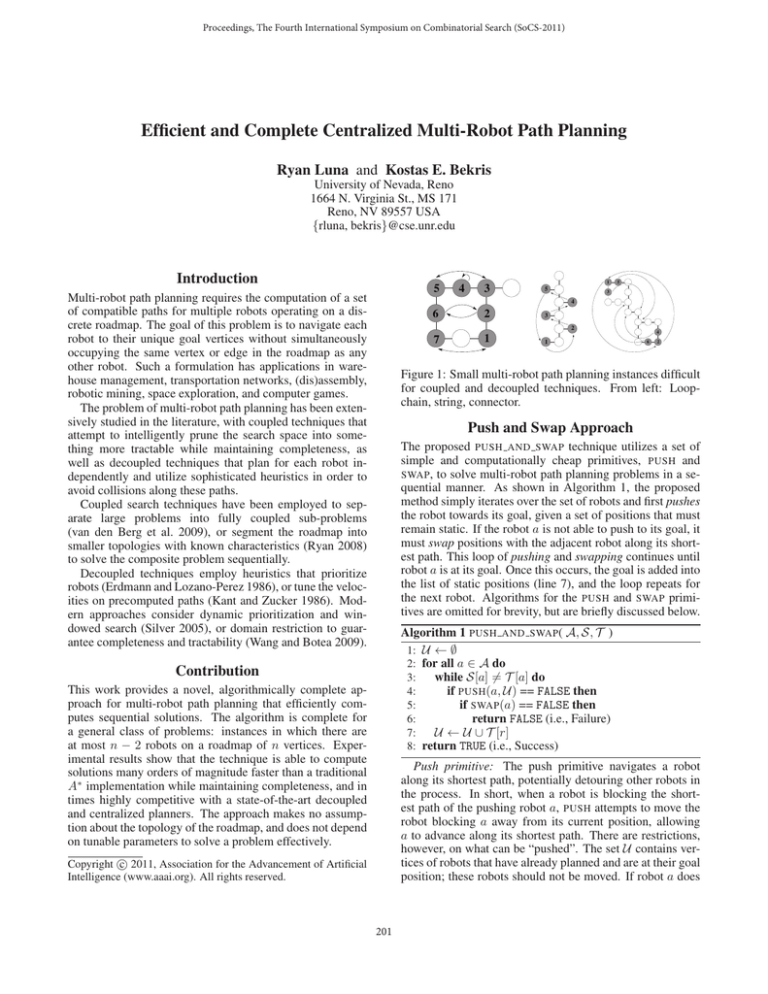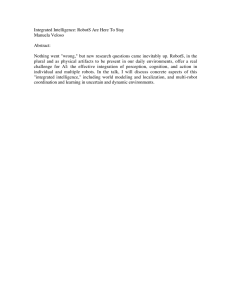
Proceedings, The Fourth International Symposium on Combinatorial Search (SoCS-2011)
Efficient and Complete Centralized Multi-Robot Path Planning
Ryan Luna and Kostas E. Bekris
University of Nevada, Reno
1664 N. Virginia St., MS 171
Reno, NV 89557 USA
{rluna, bekris}@cse.unr.edu
Introduction
5
Multi-robot path planning requires the computation of a set
of compatible paths for multiple robots operating on a discrete roadmap. The goal of this problem is to navigate each
robot to their unique goal vertices without simultaneously
occupying the same vertex or edge in the roadmap as any
other robot. Such a formulation has applications in warehouse management, transportation networks, (dis)assembly,
robotic mining, space exploration, and computer games.
The problem of multi-robot path planning has been extensively studied in the literature, with coupled techniques that
attempt to intelligently prune the search space into something more tractable while maintaining completeness, as
well as decoupled techniques that plan for each robot independently and utilize sophisticated heuristics in order to
avoid collisions along these paths.
Coupled search techniques have been employed to separate large problems into fully coupled sub-problems
(van den Berg et al. 2009), or segment the roadmap into
smaller topologies with known characteristics (Ryan 2008)
to solve the composite problem sequentially.
Decoupled techniques employ heuristics that prioritize
robots (Erdmann and Lozano-Perez 1986), or tune the velocities on precomputed paths (Kant and Zucker 1986). Modern approaches consider dynamic prioritization and windowed search (Silver 2005), or domain restriction to guarantee completeness and tractability (Wang and Botea 2009).
4
1
3
5
6
2
3
7
1
1
5
3
4
2
4
6
2
Figure 1: Small multi-robot path planning instances difficult
for coupled and decoupled techniques. From left: Loopchain, string, connector.
Push and Swap Approach
The proposed PUSH AND SWAP technique utilizes a set of
simple and computationally cheap primitives, PUSH and
SWAP , to solve multi-robot path planning problems in a sequential manner. As shown in Algorithm 1, the proposed
method simply iterates over the set of robots and first pushes
the robot towards its goal, given a set of positions that must
remain static. If the robot a is not able to push to its goal, it
must swap positions with the adjacent robot along its shortest path. This loop of pushing and swapping continues until
robot a is at its goal. Once this occurs, the goal is added into
the list of static positions (line 7), and the loop repeats for
the next robot. Algorithms for the PUSH and SWAP primitives are omitted for brevity, but are briefly discussed below.
Algorithm 1 PUSH AND SWAP( A, S, T )
1: U ← ∅
2: for all a ∈ A do
3:
while S[a] = T [a] do
4:
if PUSH(a, U ) == FALSE then
5:
if SWAP(a) == FALSE then
6:
return FALSE (i.e., Failure)
7:
U ← U ∪ T [r]
8: return TRUE (i.e., Success)
Contribution
This work provides a novel, algorithmically complete approach for multi-robot path planning that efficiently computes sequential solutions. The algorithm is complete for
a general class of problems: instances in which there are
at most n − 2 robots on a roadmap of n vertices. Experimental results show that the technique is able to compute
solutions many orders of magnitude faster than a traditional
A∗ implementation while maintaining completeness, and in
times highly competitive with a state-of-the-art decoupled
and centralized planners. The approach makes no assumption about the topology of the roadmap, and does not depend
on tunable parameters to solve a problem effectively.
Push primitive: The push primitive navigates a robot
along its shortest path, potentially detouring other robots in
the process. In short, when a robot is blocking the shortest path of the pushing robot a, PUSH attempts to move the
robot blocking a away from its current position, allowing
a to advance along its shortest path. There are restrictions,
however, on what can be “pushed”. The set U contains vertices of robots that have already planned and are at their goal
position; these robots should not be moved. If robot a does
c 2011, Association for the Advancement of Artificial
Copyright Intelligence (www.aaai.org). All rights reserved.
201
WHCA∗ (5)
∞
1.46
∞
Sp. Tree
n/a
1.97
n/a
Push-and-Swap
8.45
0.423
2.63
70
Push and Swap
WHCA*(8)
WHCA*(16)
Coupled
Spanning Tree
60
Computation Time (s)
Problem
Loop-Chain
String
Connector
Table 1: Computation time in milliseconds for the benchmarks in Figure 1. ∞ represents no solution computed.
not reach its goal because it cannot make progress by “pushing”, it returns false, indicating a SWAP is necessary.
Swap primitive: The swap primitive switches the position
of a robot a with a robot b that is adjacent to it along the
shortest path. One requirement for SWAP is that after execution, the only robots that have changed positions are a and b.
This is necessary to ensure completeness. Maintaining this
constraint is feasible by allowing all robots to move during
the swap, and reversing the actions taken once the swap is
complete. In order to maintain the swap, robot a will reverse
using b’s paths and vice-versa.
50
40
30
20
10
0
10
20
30
40
50
60
70
80
90
100
Number of Robots
Figure 2: Computation time for robots placed randomly in a
20x30 grid. Values are averages of 20 runs.
Discussion
It is important to note that the solutions generated by
PUSH AND SWAP are not optimal, and investigating whether
an optimal set of paths can be computed using the two primitives is of particular interest. Depending on the problem
domain, techniques that provide Pareto optimality (Ghrist,
O’Kane, and LaValle 2004) may also be applicable.
In addition to optimality, providing completeness in all
solvable sequential instances is desirable. PUSH AND SWAP
provides completeness in problems where there are at least
two empty vertices in the roadmap. The “15-puzzle” problem can easily be formulated as multi-robot path planning,
however this instance would only have one empty vertex. It
may be possible to create a variant of SWAP to take advantage of redundant loops in order to solve such instances.
Completeness
PUSH AND SWAP provides completeness for problems in
which there are at least two empty vertices in the roadmap.
The theorem can be proven with the following lemmas:
1) The path planning instance is solvable if and only if SWAP
can transfer two robots to the vicinity of a vertex v with a degree at least 3 together with two empty vertices.
2) After each iteration of PUSH and SWAP, at least one robot
will make progress along the shortest path to its goal.
3) The PUSH and SWAP operators do not disturb robots already at their goal vertices.
4) If the initial configuration is solvable, any permutation
achieved using PUSH and SWAP operators will be solvable.
References
Erdmann, M., and Lozano-Perez, T. 1986. On multiple
moving objects. In IEEE Intern. Conference on Robotics
and Automation (ICRA), 1419–1424.
Ghrist, R.; O’Kane, J. M.; and LaValle, S. M. 2004. Pareto
optimal coordination on roadmaps. In Workshop on the Algorithmic Foundations of Robotics (WAFR).
Kant, K., and Zucker, S. 1986. Towards efficient trajectory
planning: The path-velocity decomposition. International
Journal of Robotics Research (IJRR) 5(3):72–89.
Peasgood, M.; Clark, C.; and McPhee, J. 2008. A complete
and scalable strategy for coordinating multiple robots within
roadmaps. IEEE Transactions on Robotics 24(2):282–292.
Ryan, M. R. K. 2008. Exploiting subgraph structure in
multi-robot path planning. Journal of Artificial Intelligence
Research 31:497–542.
Silver, D. 2005. Cooperative pathfinding. In The 1st Conference on Artificial Intelligence and Interactive Digital Entertainment (AIIDE’05), 23–28.
van den Berg, J.; Snoeyink, J.; Lin, M.; and Manocha, D.
2009. Centralized path planning for multiple robots: Optimal decoupling into sequential plans. In Robotics: Science
and Systems V.
Wang, K.-H. C., and Botea, A. 2009. Tractable Multi-Agent
Path Planning on Grid Maps. In International Joint Conference on Artificial Intelligence IJCAI-09, 1870–1875.
Results
The proposed technique was evaluated with a set of small
benchmark problems, Figure 1, where it is possible to compare against a complete, centralized A∗ implementation, a
modern decoupled technique, WHCA∗ (Silver 2005), and a
scalable centralized planner that utilizes the spanning tree of
the roadmap (Peasgood, Clark, and McPhee 2008). Table
1 shows computation times for the planners on the benchmarks. The spanning tree planner is only applicable in trees
where the number of leaves is greater than the number of
robots. Times longer than 60 minutes are deemed a failure.
Large scale experiments in a 20x30 grid environment with
varying numbers of robots are also performed. The coupled A∗ approach, even with “optimal decoupling” applied
(van den Berg et al. 2009), still exhibits highly exponential
complexity. WHCA∗ scales well in this environment but
suffers from deadlocks as the number of robots increases.
The spanning tree planner achieves highly competitive times
against the proposed technique, but the path quality achieved
by this planner is poor when compared to Push-and-Swap.
Figure 2 shows a graph of the Push-and-Swap technique
against the other planners. It should be noted that Push-andSwap found solutions in 100% of simulated experiments.
202




